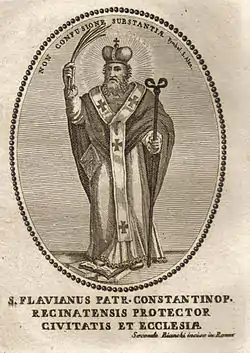Flavian of Constantinople
Flavian (Latin: Flavianus; Greek: Φλαβιανος, Phlabianos; d. 11 August 449), sometimes Flavian I, was Archbishop of Constantinople from 446 to 449. He is venerated as a saint by the Eastern Orthodox Church and the Roman Catholic Church.
Saint Flavian of Constantinople | |
|---|---|
 Saint Flavian | |
| Patriarch of Constantinople, Martyr | |
| Died | 449 Hypaepa, Lydia, Asia Minor |
| Venerated in | Eastern Orthodox Church Roman Catholic Church |
| Canonized | 451 by Council of Chalcedon |
| Major shrine | Relics venerated in Italy |
| Feast | February 16 (Orthodox Church) February 18 (Catholic Church) |
Flavian of Constantinople | |
|---|---|
| Ecumenical Patriarch of Constantinople | |
| Installed | 446 |
| Term ended | 449 |
| Personal details | |
| Denomination | Chalcedonian Christianity |
Consecration as archbishop and imperial dispute
Flavian was a presbyter and the guardian of the sacred vessels of the great Church of Constantinople and, according to Nikephoros Kallistos Xanthopoulos, was reputed to lead a saintly life, when he was chosen to succeed Proclus as Archbishop of Constantinople.[1]
During his consecration, Roman Emperor Theodosius II was staying at Chalcedon. His eunuch Chrysaphius attempted to extort a present of gold to the Emperor but as he was unsuccessful, he began to plot against the new Archbishop by supporting the archimandrite Eutyches in his dispute with Flavian.
First Council of Ephesus
Flavian presided at a council of forty bishops at Constantinople on November 8, 448, to resolve a dispute between the metropolitan bishop of Sardis and two bishops of his province. Eusebius, bishop of Dorylaeum, presented an indictment against Eutyches. The speech of Flavian remains, concluding with this appeal to the bishop of Dorylaeum: "Let your reverence condescend to visit him and argue with him about the true faith, and if he shall be found in very truth to err, then he shall be called to our holy assembly, and shall answer for himself." Eventually the synod deposed Eutyches.[2]
Second Council of Ephesus
However, as Eutyches protested against this verdict and received the support of Pope Dioscorus I of Alexandria, the Emperor convoked another Council to Ephesus. At this council, which assembled on August 8, 449, Flavian was beaten during the sessions of this council by impudent monks led by a certain Barsumas. Flavian was then deposed, exiled,[2] and the council reinstated Eutyches.
Death
Flavian died on August 11, 449, at Hypaepa in Lydia, Asia Minor and was buried obscurely.
Aftermath
Pope Leo I, whose legates had been ignored at the council, protested, first calling the council a "robber synod", and declared its decisions void.
After Theodosius II died in 450, his sister Pulcheria returned to power, marrying the officer Marcian, who became Emperor. The new Imperial couple had Flavian's remains brought to Constantinople[2] in a way that, in the words of a chronicler, more resembled "a triumph .. than a funeral procession". The Council of Chalcedon, called in 451, condemned Eutyches, confirmed Pope Leo's Tome (letter 28)[3] and canonized Flavian as a martyr.
In the Roman Catholic Church St. Flavian is commemorated on February 18, the date assigned to him in the Roman Martyrology. Flavian of Ricina is sometimes identified with him.[4][5]
See also
- St Fravitta of Constantinople, known as Flavian or Flavianus II in some sources
References
- Rudge, F.M. "St. Flavian." The Catholic Encyclopedia Vol. 6. New York: Robert Appleton Company, 1909. 6 February 2019
- "St. Flavian the Confessor the Patriarch of Constantinople", Orthodox Church in America
- Pope Leo I. "Letter 28 - The Tome". New Advent. Retrieved 2011-02-18.
- Borelli, Antonio. "San Flaviano di Ricina", Santi e Beati, February 23, 2005
- Among the documents which touch on the career of Flavian are the reply of Petrus Chrysologus, archbishop of Ravenna, to a circular appeal of Eutyches, and various letters of Theodoret. Pope Leo I wrote Flavian a beautiful letter before hearing that he was dead.
- Attribution
 This article incorporates text from a publication now in the public domain: Wace, Henry; Piercy, William C., eds. (1911). "Flavianus (8), bp. of Constantinople". Dictionary of Christian Biography and Literature to the End of the Sixth Century (3rd ed.). London: John Murray.
This article incorporates text from a publication now in the public domain: Wace, Henry; Piercy, William C., eds. (1911). "Flavianus (8), bp. of Constantinople". Dictionary of Christian Biography and Literature to the End of the Sixth Century (3rd ed.). London: John Murray.
- Evagrius. ii. 2. etc.
- Facund, Pro Trib. Capit. viii. 5; xii. 5.
- Leo. Mag. Epp. 23, 26, 27, 28, 44.
- Liberatus Diac. Breviar. xi. xii.
- Nicephorus, Constant. xiv. 47.
- Sozomen H. E. ix. 1.
- Theophanes the Confessor, Chronology pp. 84–88.
Bibliography
- Meyendorff, John (1989). Imperial unity and Christian divisions: The Church 450-680 A.D. The Church in history. 2. Crestwood, NY: St. Vladimir's Seminary Press. ISBN 978-0-88-141056-3.
External links
- St Flavian of Constantinople Orthodox Synaxarion (February 18)
| Titles of the Great Christian Church | ||
|---|---|---|
| Preceded by Proclus |
Archbishop of Constantinople 446–449 |
Succeeded by Anatolius |